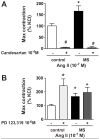Early life stress enhances angiotensin II-mediated vasoconstriction by reduced endothelial nitric oxide buffering capacity
- PMID: 21876076
- PMCID: PMC3754790
- DOI: 10.1161/HYPERTENSIONAHA.110.168674
Early life stress enhances angiotensin II-mediated vasoconstriction by reduced endothelial nitric oxide buffering capacity
Abstract
We reported previously that maternal separation (MS) sensitizes adult rats to angiotensin II (Ang II)-induced hypertension. The aim of this study was to investigate the vascular reactivity to Ang II and the role of renin-angiotensin system components, reactive oxygen species production, and NO synthase (NOS) buffering capacity mediating the exacerbated Ang II-induced responses. MS rats were separated from their mothers for 3 h/d from days 2 to 14 of life. Controls were nonhandled littermates. At 12 weeks of age, aortic Ang II-induced constriction was greater from MS rats compared with controls (P<0.05); moreover, endothelial denudation abolished this difference. The response to other constrictors was unchanged. Angiotensin type 2 receptor function was reduced in aortic Ang II-induced constriction from MS rats compared with controls. Angiotensin type 1 receptor function was similarly abolished in both groups. However, protein expressions of angiotensin type 1 and angiotensin type 2 receptors were similar in aortic rings from MS and control rats. Preincubation with superoxide inhibitor or scavenger attenuated the Ang II-induced vasoconstriction in control but not in MS rats. However, acute preincubation with an NOS inhibitor enhanced aortic Ang II-induced constriction in aorta from control rats, but this effect was significantly reduced in MS rats compared with control rats. Accordingly, a further increase in Ang II-induced hypertension attributed to chronic NOS inhibition (days 10 to 13) was blunted in MS rats compared with control rats. Similar NOS expression and activity were observed in control and MS rats. In conclusion, MS induces a phenotype with reduced endothelial NOS buffering capacity leading to dysfunctional endothelial Ang II-mediated signaling and sensitization to Ang II-induced vasoconstriction.
Figures







References
-
- Kelishadi R, Mirghaffari N, Poursafa P, Gidding SS. Lifestyle and environmental factors associated with inflammation, oxidative stress and insulin resistance in children. Atherosclerosis. 2009;203:311–319. - PubMed
-
- Caldji C, Diorio J, Meaney MJ. Variations in maternal care in infancy regulate the development of stress reactivity. Biol Psychiatry. 2000;48:1164–1174. - PubMed
-
- Samuelsson AM, Matthews PA, Argenton M, Christie MR, McConnell JM, Jansen EH, Piersma AH, Ozanne SE, Twinn DF, Remacle C, Rowlerson A, Poston L, Taylor PD. Diet-induced obesity in female mice leads to offspring hyperphagia, adiposity, hypertension, and insulin resistance: a novel murine model of developmental programming. Hypertension. 2008;51:383–392. - PubMed
-
- Enthoven L, de Kloet ER, Oitzl MS. Differential development of stress system (re)activity at weaning dependent on time of disruption of maternal care. Brain Res. 2008;1217:62–69. - PubMed
Publication types
MeSH terms
Substances
Grants and funding
LinkOut - more resources
Full Text Sources
Miscellaneous

